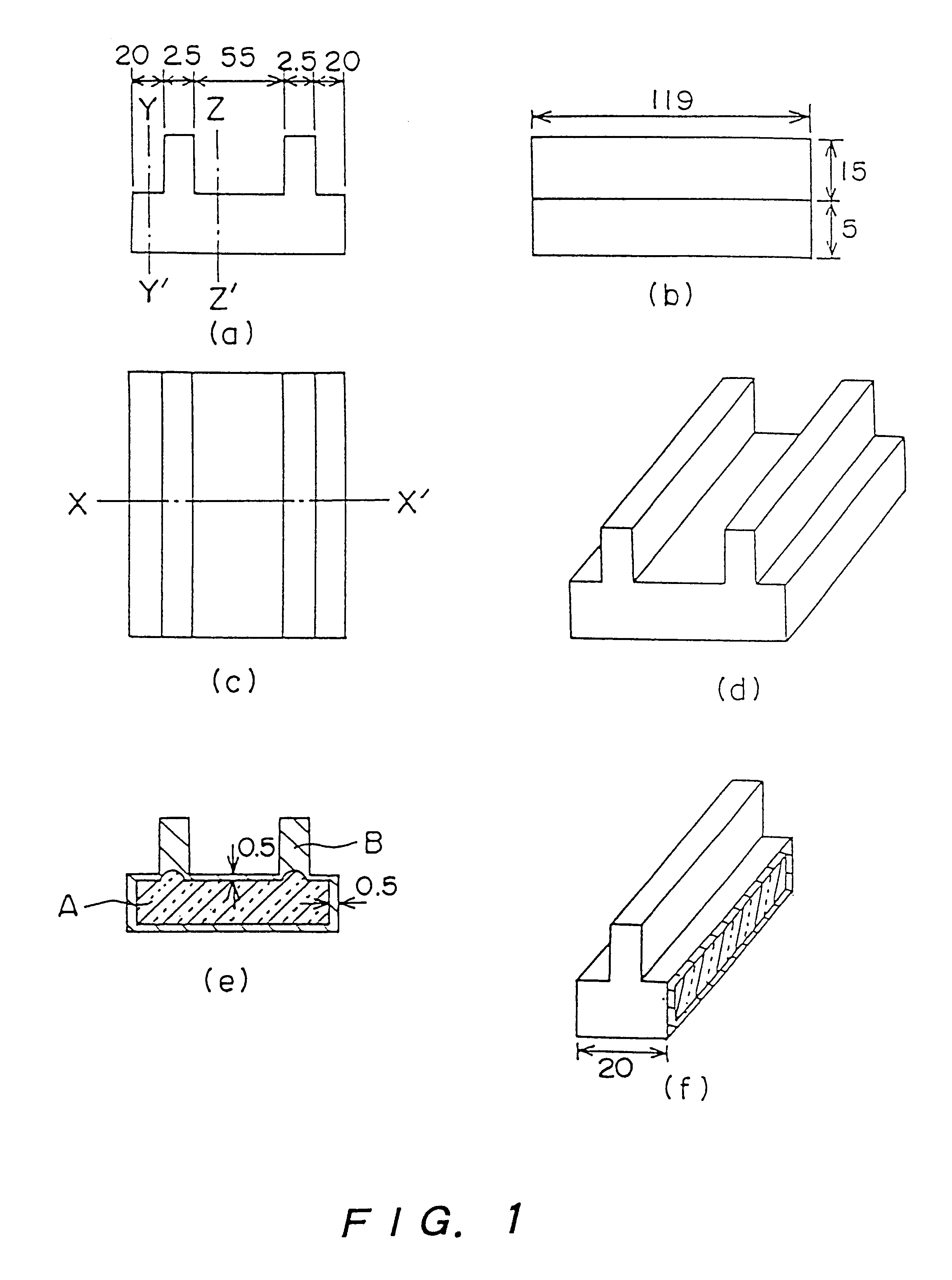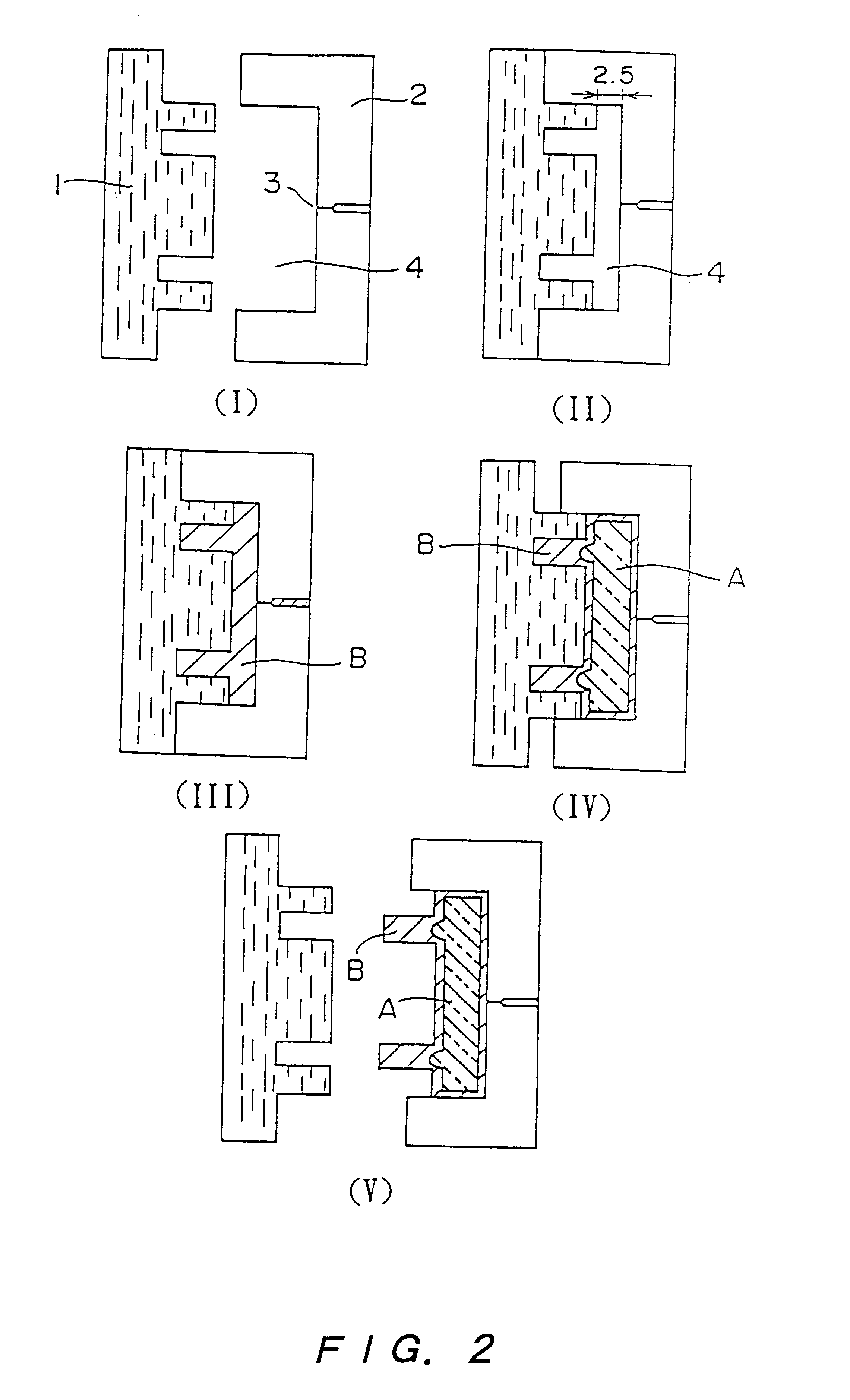Method for producing molded article
- Summary
- Abstract
- Description
- Claims
- Application Information
AI Technical Summary
Benefits of technology
Problems solved by technology
Method used
Image
Examples
example 2
Propylene homopolymer having the MFR of 4.5 g / 10 min and the melting point of 164.degree. C. was mixed with azodicarbonamide with mixing ratio of 98.5 wt %:1.5 wt % (propylene homopolymer:azodicarbonamide) and the mixture was stirred in the same manner as in Example 1 to give a expandable thermoplastic molding material. The same injection molding machine as in Example 1 except for the shape of the mobile mold was used. The temperature of each band heater of the heating cylinder was set to 230.degree. C., 230.degree. C., 230.degree. C., and 210.degree. C. from the tip part and 180.degree. C. at the rear part. The back pressure and the temperature of cooling water of the metal mold were adjusted to 100 kg / cm.sup.2 and 40.degree. C., respectively. The thickness of the cavity (between the mobile mold and the fixed mold), which was corresponding to the bottom part of the molded article, was adjusted to 2.5 mm and the total volume of the cavity was adjusted to 39 cc. Then, 35 g of the abo...
example 3
Propylene homopolymer having the MFR of 4.5 g / 10 min and the melting point of 164.degree. C. was mixed with azodicarbonamide with mixing ratio of 98.5 wt %:1.5 wt % (propylene homopolymer:azodicarbonamide) and the mixture was stirred in the same manner as in Example 1 to give a expandable thermoplastic molding material. The same injection molding machine as in Example 1 except for the shape of the mold was used. The temperature of each band heater of the heating cylinder was set to 230.degree. C., 230.degree. C., 230.degree. C., and 210.degree. C. from the tip part and 180.degree. C. at the rear part. The back pressure and the temperature of cooling water of the metal mold were adjusted to 100 kg / cm.sup.2 and 40.degree. C., respectively. The thickness of the cavity (between the mobile mold and the fixed mold), which was corresponding to the bottom part of the molded article, was adjusted to 2.5 mm and the total volume of the cavity was adjusted to 34 cc. Then, 31 g of the above ment...
example 4
Propylene homopolymer having the MFR of 4.5 g / 10 min and the melting point of 164.degree. C. was mixed with azodicarbonamide with mixing ratio of 98.5 wt %:1.5 wt % (propylene homopolymer:azodicarbonamide) and the mixture was stirred in the same manner as in Example 1 to give a expandable thermoplastic molding material. The same injection molding machine as in Example 1 except for the shape of the mold was used. The temperature of each band heater of the heating cylinder was set to 230.degree. C., 230.degree. C., 230.degree. C., and 210.degree. C. from the tip part and 180.degree. C. at the rear part. The back pressure and the temperature of cooling water of the metal mold were adjusted to 100 kg / cm.sup.2 and 40.degree. C., respectively. The thickness of the cavity (between the mobile mold and the fixed mold), which was corresponding to the bottom part of the molded article, was adjusted to 2.5 mm and the total volume of the cavity was adjusted to 48 cc. Then, 43 g of the above ment...
PUM
| Property | Measurement | Unit |
|---|---|---|
| Fraction | aaaaa | aaaaa |
| Linear density | aaaaa | aaaaa |
| Angle | aaaaa | aaaaa |
Abstract
Description
Claims
Application Information
 Login to View More
Login to View More - R&D
- Intellectual Property
- Life Sciences
- Materials
- Tech Scout
- Unparalleled Data Quality
- Higher Quality Content
- 60% Fewer Hallucinations
Browse by: Latest US Patents, China's latest patents, Technical Efficacy Thesaurus, Application Domain, Technology Topic, Popular Technical Reports.
© 2025 PatSnap. All rights reserved.Legal|Privacy policy|Modern Slavery Act Transparency Statement|Sitemap|About US| Contact US: help@patsnap.com



